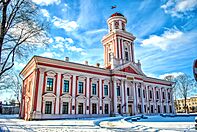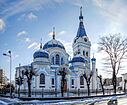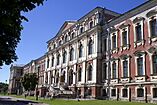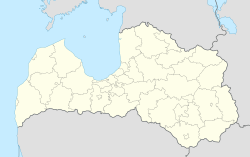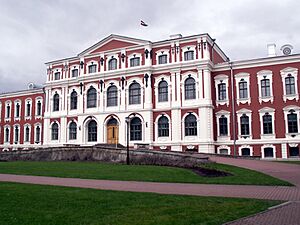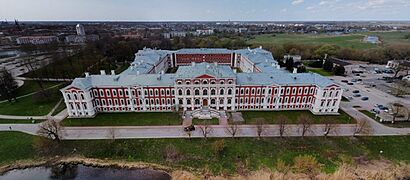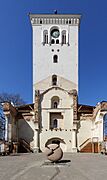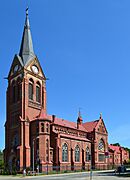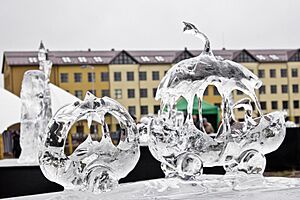Jelgava facts for kids
Quick facts for kids
Jelgava
|
|||||
|---|---|---|---|---|---|
|
State city
|
|||||
|
Aerial View of Jelgava
Academia Petrina
Cathedral of the Immaculate Virgin Mary
St Simeon and St Anne's Cathedral
Jelgava Palace
|
|||||
|
|||||
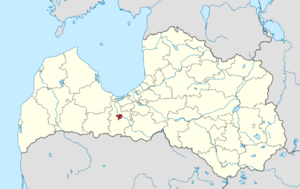
Jelgava highlighted in Latvia.
|
|||||
| Country | |||||
| Town rights | 1573 | ||||
| Area | |||||
| • Total | Lua error in Module:Wd at line 1,575: attempt to index field 'wikibase' (a nil value). km2 (Formatting error: invalid input when rounding sq mi) | ||||
| • Land | Lua error in Module:Wd at line 1,575: attempt to index field 'wikibase' (a nil value). km2 (Formatting error: invalid input when rounding sq mi) | ||||
| • Water | Expression error: Unexpected < operator. km2 (Formatting error: invalid input when rounding sq mi) | ||||
| Elevation | 13 m (43 ft) | ||||
| Population
(2024)
|
|||||
| • Total | 54,701 | ||||
| Demonym(s) | Jelgavnieki (Latvian) | ||||
| GDP | |||||
| • State city | 740,034,000 Euro (2021) | ||||
| • Per capita | 13,462 Euro (2021) | ||||
| Time zone | UTC+2 (EET) | ||||
| • Summer (DST) | UTC+3 (EEST) | ||||
| Postal code |
LV-300(1–9); LV-3024; LV-3035
|
||||
| Calling code | (+371) 630 | ||||
Jelgava is a city in central Latvia. It is about 41 kilometers (25 miles) southwest of Riga. Jelgava is the biggest town in the Zemgale region. It used to be the capital of the Duchy of Courland and Semigallia from 1578 to 1795. Later, it was the main city of the Courland Governorate until 1918.
Jelgava is on a flat, fertile plain. It is only about 3.5 meters (11 feet) above sea level. The city is on the right bank of the Lielupe river. Sometimes, when the water is very high, the plain and even parts of the town can flood. Jelgava is an important railway center. Many railway lines meet here, connecting Riga to Lithuania, and different parts of Latvia. It also has the Jelgava Air Base.
Contents
What's in a Name?
Before 1917, the city was officially called Mitau. The name Jelgava might come from the Livonian language word jālgab. This word means "town on the river."
The origin of the German name Mitau is not fully clear. Some people think it comes from the Latvian language words mīt or mainīt. These words mean "to exchange" or "to trade." So, Mitau could have meant "trading-place." Another idea is that Mitau came from Mitte in der Aue. This is German for "the middle of the Aa," referring to the Lielupe River. This river was once known as the Courland Aa.
In Yiddish, the city was called מיטאַווע (Mitave) or מיטאַו (Mitar). During the Soviet period, the city's name was sometimes written as "Yelgava" in English. This was a way of writing the Russian name Елгава.
Jelgava's Story
A settlement started to grow in the Mitau area around the 10th century. This was between the Lielupe and Driksa rivers. In 1265–1266, the Livonian Order built a castle in Mitau. This castle was on a natural island called Pilssala. The German knights used Mitau as a southern fort. They took control of the Livonians and Semigallians nearby by 1290.
The town became more important as a defense point against the Lithuanians. The Lithuanians managed to rob Mitau in 1345.
Becoming a Capital
After the Livonian War (1558-1583), Mitau became part of the Duchy of Courland in 1561. The city gained its official city rights in 1573. In 1578, it became the capital of the united duchies of Courland and Semigallia. When the Duchy of Courland split in 1596, Mitau was where Duke Friedrich Kettler of Semigallia lived. The city became the capital of the united duchies again in 1617.
Because the duchy was linked to the Polish–Lithuanian Commonwealth, Mitau was also called Mitawa in Polish. Wars between the Commonwealth and Sweden led to Mitau being attacked several times. Despite the wars, the city grew as a place for trade and business. However, as Courland's neighbors became stronger, the duchy and Mitau started to come under Russia's influence.
Russian Influence and Cultural Growth
In 1710, Duke Friedrich Wilhelm married Anna Ioannovna. She was the daughter of Tsar Ivan V and later became Empress of Russia. Sadly, Friedrich Wilhelm died soon after. Anna then ruled as the duchess of Courland from 1711 to 1730.
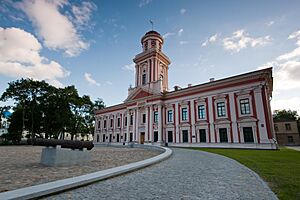
The duke Ernst Johann von Biron (1737–1740 and 1763–1769) helped Mitau grow culturally. He built the ducal palace and opened the city's first public library. In 1775, the last Duke of Courland, Peter von Biron (1769–1795), started the Academia Petrina. This became an important cultural center. The duke also supported theater at his court.
Changes and Challenges
When the French Revolution began in 1789, people in Mitau wanted more rights. Later, Imperial Russia took over the city as part of Courland in 1795. This happened during the Third Partition of Poland. The Count of Provence (who later became French king Louis XVIII) lived at the palace of Mitau from 1798–1801 and 1804–1807. Even though Prussian troops occupied the city during the Napoleonic Wars, it was mostly saved from being destroyed.
Mitau grew even more after the railway was built in 1868. This made it easier for people from the countryside to move to the city. They came to work as merchants, craftspeople, teachers, and officials. By 1914, Mitau had over 45,000 people.
However, Mitau suffered a lot during World War I (1914-1918). The brave defense of Mitau by Latvian soldiers in 1915 helped inspire the creation of the Latvian Rifles. German troops occupied the city during the war. British prisoners of war were forced to work there and faced terrible conditions.
After the war, in 1919, Mitau became a battlefield. Bolshevik Red Guards, German soldiers, and Latvian freedom-fighters fought here. After the Latvians won in November 1919, Mitau was renamed Jelgava. It became an important city in independent Latvia. In 1925, the first sugar factory in Latvia was built in Jelgava. In 1939, the Latvia University of Life Sciences and Technologies opened in the Jelgava Palace.
World War II and Rebuilding
Because of the Nazi-Soviet Pact of 1939, Jelgava and the rest of Latvia were taken over by the Soviet Union in 1940. Many German people living in the city were moved to German-controlled Poland. German forces occupied Jelgava from 1941 to 1944. During World War II, the city's Jewish community suffered greatly. The main synagogue was burned down.
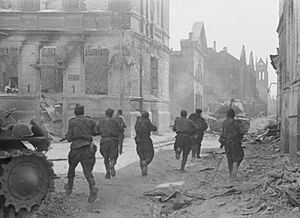
In July 1944, the Soviet Red Army attacked towards Jelgava. The city was declared a fortress. However, there were only a few German and Latvian units there. From July 30 to August 7, after heavy street fighting and air raids, the Red Army took control of the left bank of the Lielupe river. Jelgava remained on the front line until October 10, when the German army left for Courland.
The city's old center, factories, railway, and public buildings were badly damaged. Almost 90% of the city was destroyed. The famous Kurland Provincial Museum and Athenaeum was also lost.
After World War II, Jelgava was rebuilt in a typical Soviet style. It became home to several large factories. These included the sugar factory and buildings for the Riga Autobus Factory (RAF).
After Latvia became independent again, Jelgava slowly brought back its original heritage. It is now a popular place for tourists. Many people in Jelgava are students or work in education because of the Latvia University of Life Sciences and Technologies. This is why Jelgava is sometimes called the Student capital of Latvia.
Climate
Jelgava has a humid continental climate. This means it has warm summers and cold winters.
| Climate data for Jelgava (1991−2020 normals, extremes 1867−present) | |||||||||||||
|---|---|---|---|---|---|---|---|---|---|---|---|---|---|
| Month | Jan | Feb | Mar | Apr | May | Jun | Jul | Aug | Sep | Oct | Nov | Dec | Year |
| Record high °C (°F) | 10.7 (51.3) |
13.5 (56.3) |
19.7 (67.5) |
27.4 (81.3) |
30.0 (86.0) |
32.8 (91.0) |
36.0 (96.8) |
33.7 (92.7) |
30.1 (86.2) |
23.4 (74.1) |
17.0 (62.6) |
11.6 (52.9) |
36.0 (96.8) |
| Mean daily maximum °C (°F) | −0.3 (31.5) |
0.3 (32.5) |
4.9 (40.8) |
12.4 (54.3) |
18.1 (64.6) |
21.3 (70.3) |
23.9 (75.0) |
23.1 (73.6) |
17.8 (64.0) |
10.8 (51.4) |
4.8 (40.6) |
1.1 (34.0) |
11.5 (52.7) |
| Daily mean °C (°F) | −2.7 (27.1) |
−2.7 (27.1) |
0.7 (33.3) |
6.7 (44.1) |
12.0 (53.6) |
15.5 (59.9) |
17.9 (64.2) |
17.0 (62.6) |
12.3 (54.1) |
6.9 (44.4) |
2.5 (36.5) |
−0.9 (30.4) |
7.1 (44.8) |
| Mean daily minimum °C (°F) | −5.7 (21.7) |
−6.2 (20.8) |
−3.6 (25.5) |
1.1 (34.0) |
5.1 (41.2) |
8.9 (48.0) |
11.6 (52.9) |
10.8 (51.4) |
7.0 (44.6) |
2.9 (37.2) |
−0.1 (31.8) |
−3.6 (25.5) |
2.4 (36.3) |
| Record low °C (°F) | −34.5 (−30.1) |
−34.9 (−30.8) |
−30.1 (−22.2) |
−14.2 (6.4) |
−5.3 (22.5) |
−1.1 (30.0) |
2.8 (37.0) |
0.3 (32.5) |
−6.4 (20.5) |
−10.1 (13.8) |
−22.4 (−8.3) |
−32.2 (−26.0) |
−34.9 (−30.8) |
| Average precipitation mm (inches) | 43.6 (1.72) |
34.8 (1.37) |
33.8 (1.33) |
36.0 (1.42) |
52.4 (2.06) |
73.4 (2.89) |
82.1 (3.23) |
69.4 (2.73) |
59.9 (2.36) |
68.2 (2.69) |
50.4 (1.98) |
47.1 (1.85) |
651.1 (25.63) |
| Average precipitation days | 11 | 9 | 9 | 7 | 9 | 10 | 11 | 10 | 10 | 11 | 11 | 11 | 119 |
| Average relative humidity (%) | 87.5 | 84.9 | 78.5 | 71.4 | 70.5 | 74.5 | 77.9 | 78.7 | 83.1 | 86.6 | 89.4 | 89.6 | 81.0 |
| Source 1: LVĢMC | |||||||||||||
| Source 2: NOAA (humidity and precipitation days 1991-2020) | |||||||||||||
People of Jelgava
As of January 1, 2022, Jelgava had 54,694 people living there.
| Demographics of Jelgava 2022 | ||||
|---|---|---|---|---|
| Latvians | 60.1% | |||
| Russians | 26.8% | |||
| Belarusians | 4.8% | |||
| Ukrainians | 2.3% | |||
| Poles | 1.7% | |||
| Lithuanians | 1.3% | |||
| Others | 3% | |||
Places to See
Before World War II, Jelgava had wide, straight streets. They were lined with large houses of the Baltic German noble families.
The old castle (built in 1266) was on an island in the river. It was destroyed by Duke Biren. He then had a large palace built (1738–1772) by Bartolomeo Rastrelli. This palace is at the bridge across the Lielupe. Inside the palace are the tombs of almost all the Curonian dukes. The future Louis XVIII stayed in the palace between 1798 and 1800. Today, it is home to the Latvia University of Life Sciences and Technologies.
Other important buildings include:
- The Baroque church of St. Anne's Church (Liela Street 22a).
- The tower of the destroyed Jelgava St. Trinity Church (Akadēmijas Street 1).
- Two beautiful buildings: the Villa Medem and the Academia Petrina.
You can also visit:
- Jelgava Palace (Lielā Street 2)
- Jelgava Old Town
- Cathedral of the Immaculate Virgin Mary (Katoļu Street 11)
- St Simeon and St Anne's Cathedral (Raina Street 5)
- St. John's Church (Jāņa Street 1)
- Jelgava Baptist Church (Matera Street 54)
- Love Alley (Dobele highway)
- Valdeka Castle (Rīgas Street 22)
- Jelgava Station (Stacijas Street 1)
Culture and Fun
Jelgava hosts many exciting events throughout the year:
- International Ice Sculpture Festival
- Student Folk Festival
- Easter Walk
- Latvian Plant Days
- Jelgava City Festival
- Summer solstice celebrations
- International Cat Show "Jelgava Cat"
- Sports Day
- International Sand Sculpture Festival
- Latvian Milk, Bread and Honey Festival and Milk Packet Boat Regatta
- Metal Festival
- Student Days
- New Year's Eve celebrations
Museums and Libraries
You can learn a lot at these museums in Jelgava:
- Ģederts Eliass Jelgava History and Art Museum
- Adolf Alunan Memorial Museum
- Historical displays at the St. Trinity Church tower
- Latvia University of Agriculture Museum
- Rundāle Castle museum exhibit in Jelgava Castle, showing the "Tombs of the Dukes of Kurzeme and Zemgale"
- Latvian Railway Museum Jelgava exhibit
- Firefighter exhibit
The city also has several libraries:
- Jelgava City Library (Akadēmijas Street 26)
- Pārlielupe Library (Loka highway 17)
- Miezīte Library (Dobele highway 100)
- Children's library "Zinītis" (Lielā Street 15)
Parks and Green Spaces
Jelgava has many beautiful parks and green areas where you can relax and enjoy nature:
- Jelgava Castle Park
- Station Park
- Rainis Park
- Duke Jacob's Square
- Alunāns Park
- Svētbirze
- Ozolpils Park
- Valdeka Park
- Victory Park
- Lielupe floodplain meadows
- Grēbner Park
Sports
The main football team in Jelgava is FK Jelgava. They play in the Latvian Higher League. This team has won the Latvian Football Cup four times.
Famous People from Jelgava
Many notable people have come from Jelgava, including:
- Johann Heinrich Baumann (1753-1832) – a painter
- Peter von Biron (1724-1800) – a Duke of Courland
- Renārs Kaupers (born 1974) – a famous Latvian singer
- Jānis Lūsis (1939-2020) – a well-known javelin thrower
- Elza Radziņa (1917-2005) – a Latvian actress
- Einars Repše (born 1961) – a Latvian politician
- Artūrs Skrastiņš (born 1974) – a stage and film actor
- Gunars Upatnieks (born 1983) – a musician
Sister Cities
Jelgava has sister city relationships with many cities around the world. These partnerships help promote cultural exchange and friendship.
 Pärnu, Estonia (1957)
Pärnu, Estonia (1957) Šiauliai, Lithuania (1960)
Šiauliai, Lithuania (1960) Vejle, Denmark (1992)
Vejle, Denmark (1992) Białystok, Poland (1994)
Białystok, Poland (1994) Xinying (Tainan), Taiwan (2000)
Xinying (Tainan), Taiwan (2000) Alcamo, Italy (2002)
Alcamo, Italy (2002) Hällefors, Sweden (2004)
Hällefors, Sweden (2004) Nacka, Sweden (2004)
Nacka, Sweden (2004) Rueil-Malmaison, France (2006)
Rueil-Malmaison, France (2006) Ivano-Frankivsk, Ukraine (2007)
Ivano-Frankivsk, Ukraine (2007) Nova Odessa, Brazil (2007)
Nova Odessa, Brazil (2007) Como, Italy (2016)
Como, Italy (2016) Carmel, United States (2022)
Carmel, United States (2022)
In 2022, Jelgava stopped its cooperation agreements with Magadan and Baranavichy. This was due to the Russian invasion of Ukraine.
Images for kids
See also
 In Spanish: Jelgava para niños
In Spanish: Jelgava para niños



